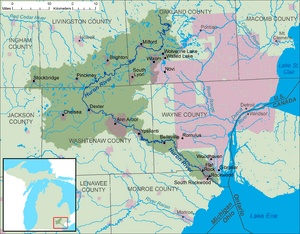Huron River (Michigan) facts for kids
Quick facts for kids Huron River |
|
|---|---|

Huron River in Ypsilanti
|
|

A map of the Huron River and its watershed.
|
|
| Country | United States |
| Physical characteristics | |
| Main source | Huron Swamp south of Andersonville, Michigan 1,001 ft (305 m) |
| River mouth | Lake Erie southeast of Rockwood, Michigan 571 ft (174 m) |
| Length | 130 mi (210 km) |
| Basin features | |
| Basin size | 908 sq mi (2,350 km2) |
The Huron River is a cool river in southeastern Michigan. It starts in the Huron Swamp in Indian Springs Metropark. This park is in northern Oakland County. The river then flows for about 130 miles (209 km). It finally empties into Lake Erie.
Contents
Where the River Flows
The Huron River begins its journey in a swampy area. This area is like a big, wet sponge. It collects water from rain and melting snow. From there, the river winds its way through many different places. It flows through five counties in Michigan. These counties are Oakland, Livingston, Washtenaw, Wayne, and Monroe. The river passes through cities like Ann Arbor and Ypsilanti. It also goes through many smaller towns and natural areas.
River's Journey to Lake Erie
The river's path is quite long. It drops about 430 feet (131 meters) from its start to its end. This drop creates some faster-moving sections. It also forms calmer areas. These calm spots are great for different kinds of plants and animals. The river's water eventually reaches Lake Erie. Lake Erie is one of the five Great Lakes.
Wildlife in the Huron River
The Huron River is home to many different animals. It has a rich ecosystem. This means it's a place where many living things interact.
Fish and Other Water Creatures
Many types of fish live in the river. You can find small fish like minnows. There are also bigger fish like bass and pike. Anglers (people who fish) enjoy catching these. Other creatures live in the water too. These include crayfish, mussels, and many kinds of insects. These small animals are food for the fish. They are also important for keeping the river clean.
Animals Near the Riverbanks
Along the riverbanks, you might see many birds. Ducks, geese, and herons are common. Sometimes, you can spot eagles looking for fish. Mammals like deer, raccoons, and muskrats also live near the river. They use the river for water and food. The river's natural areas provide a safe home for them.
Fun Things to Do
The Huron River offers many chances for outdoor fun. It's a popular spot for people of all ages.
Boating and Paddling
Many people love to go kayaking or canoeing on the river. The calm sections are perfect for beginners. More experienced paddlers can enjoy longer trips. There are several places to rent boats. You can also launch your own. It's a great way to see nature up close.
Fishing and Parks
Fishing is a very popular activity. People fish from the banks or from boats. Many parks are located along the river. These parks offer picnic areas, playgrounds, and walking trails. Some parks even have special spots for launching canoes. Gallup Park in Ann Arbor is a well-known example. It has trails, boat rentals, and a nature play area.
Hiking and Biking Trails
There are many trails along the Huron River. These trails are great for hiking and biking. They let you explore the river's beauty. You can see different plants and animals. It's a good way to get exercise and enjoy the outdoors.
Why the Huron River is Important
The Huron River is more than just a waterway. It's very important to the local environment and communities.
Water Supply and Recreation
The river provides drinking water for some towns. It also helps with farming. Its natural beauty supports tourism. Many people visit the area for outdoor activities. This helps local businesses.
Protecting the River
People work hard to keep the Huron River healthy. Groups like the Huron River Watershed Council help protect it. They teach people about the river. They also work to keep its water clean. This ensures the river stays beautiful for future generations. Protecting the river means protecting its wildlife and our water.
Images for kids


